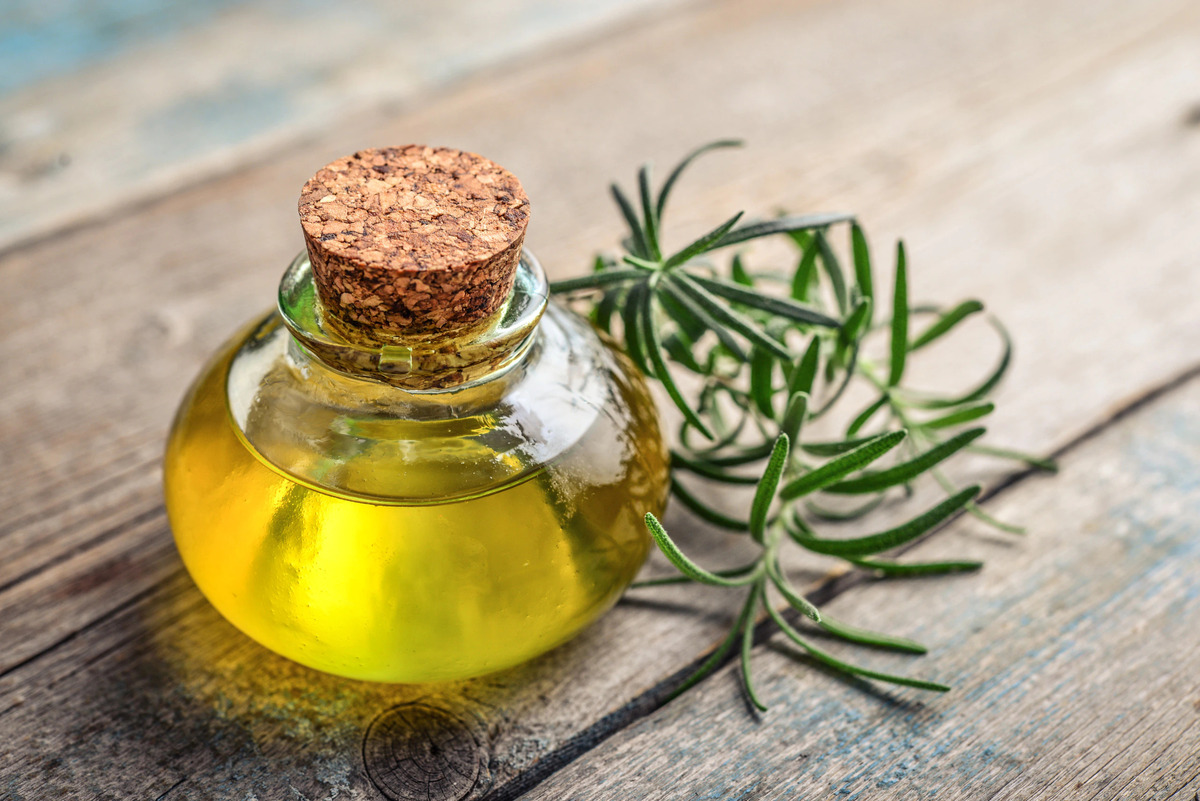Home>Gardening Techniques>DIY Projects>How Much Rosemary Oil Should Be Added To Carrier Oil?


DIY Projects
How Much Rosemary Oil Should Be Added To Carrier Oil?
Modified: January 27, 2024
Discover the perfect ratio of rosemary oil to carrier oil for your DIY projects. Get expert tips and advice on using rosemary oil effectively.
(Many of the links in this article redirect to a specific reviewed product. Your purchase of these products through affiliate links helps to generate commission for Chicagolandgardening.com, at no extra cost. Learn more)
Table of Contents
- Introduction
- Understanding Rosemary Oil
- Benefits of Rosemary Oil in Carrier Oils
- Factors to Consider
- Recommended Rosemary Oil to Carrier Oil Ratios
- Carrier Oils Suitable for Rosemary Oil
- How to Blend Rosemary Oil with Carrier Oils
- Application and Usage Tips
- Safety Precautions and Potential Side Effects
- Conclusion
Introduction
Welcome to the world of DIY projects! Whether you’re a seasoned DIY enthusiast or just starting out, one thing is for certain – the satisfaction of creating something with your own hands is unparalleled. DIY projects allow you to unleash your creativity, learn new skills, and transform ordinary materials into extraordinary works of art.
But where do you begin? With so many DIY project ideas out there, it can be overwhelming to know where to start. That’s where we come in. As SEO experts with a deep knowledge of DIY projects, we’re here to guide you on your DIY journey.
In this comprehensive guide, we’ll provide you with valuable insights and tips to help you make the most of your DIY projects. Whether you’re looking to revamp your home decor, create unique gifts for loved ones, or simply explore your inner artist, we’ve got you covered.
Throughout this article, we’ll focus on the importance of using the right techniques, materials, and tools to achieve professional-quality results. We’ll dive into specific DIY project categories such as woodworking, painting, sewing, and more, offering step-by-step instructions and expert advice.
Furthermore, we’ll also touch on the importance of SEO optimization for your DIY projects. With the right SEO strategies, you can increase the visibility of your projects online, reach a wider audience, and gain recognition for your creativity.
So, whether you’re a seasoned DIY pro or a beginner looking to embark on your first project, get ready to be inspired, learn, and create something truly remarkable. Let’s dive in and discover the wonderful world of DIY projects together!
Understanding Rosemary Oil
Rosemary oil is a versatile and aromatic essential oil that has been used for centuries for its numerous health benefits. It is derived from the leaves of the rosemary plant through a process of steam distillation.
Known for its distinct herbal fragrance, rosemary oil offers a wide range of therapeutic properties. It is rich in antioxidants and has antibacterial, antifungal, and anti-inflammatory properties. This makes it a popular ingredient in various beauty and wellness products, as well as a staple in the field of aromatherapy.
Rosemary oil is also highly regarded for its stimulating and energizing effects on the mind and body. It is believed to improve cognitive function, boost memory, and enhance focus and concentration. This makes it an ideal choice for those looking to improve their productivity and mental clarity.
Furthermore, rosemary oil is also known for its potential benefits in promoting hair growth and reducing hair loss. It is often used in hair care products to strengthen the hair follicles, stimulate blood circulation to the scalp, and combat dandruff and scalp conditions.
In addition to its aromatic and therapeutic properties, rosemary oil is commonly used in DIY projects for its ability to add a natural and refreshing scent to homemade products. It blends well with a variety of carrier oils, making it an excellent choice for creating custom fragrances for candles, soaps, and skincare products.
However, it’s important to note that rosemary oil is potent and should be used with caution. It is recommended to dilute it with a suitable carrier oil before applying it to the skin or using it in DIY projects. This ensures that it is safe for use and minimizes the risk of skin irritation or sensitization.
Now that we have a better understanding of rosemary oil and its benefits, let’s explore how it can be effectively used in combination with carrier oils in DIY projects.
Benefits of Rosemary Oil in Carrier Oils
When combined with carrier oils, rosemary oil offers a plethora of benefits that can enhance the effectiveness of your DIY projects. Here are some key advantages of incorporating rosemary oil in carrier oils:
- Improved Hair and Scalp Health: Rosemary oil has long been praised for its positive effects on hair and scalp health. When blended with carrier oils such as coconut oil or jojoba oil, it nourishes the hair follicles, stimulates hair growth, and helps to combat dandruff and dryness.
- Antioxidant Protection: Rosemary oil is packed with antioxidants, which help to neutralize harmful free radicals that can damage the skin and hair. By adding rosemary oil to carrier oils like argan oil or grapeseed oil, you can create a powerful antioxidant blend that helps to protect and rejuvenate your skin and hair.
- Enhanced Massage Experience: When used in massage oils, rosemary oil can provide a soothing and invigorating experience. By blending it with carrier oils like sweet almond oil or avocado oil, you can create a massage oil that not only moisturizes the skin but also helps to relax muscles and relieve tension.
- Boosted Aromatherapy Benefits: Aromatherapy is a popular practice that harnesses the power of essential oils to promote physical and emotional well-being. By combining rosemary oil with carrier oils like lavender oil or eucalyptus oil, you can create custom aromatherapy blends that uplift the mood, alleviate stress, or promote better sleep.
- Skin Rejuvenation: Rosemary oil is known for its astringent and anti-inflammatory properties, making it beneficial for problem-prone skin. When mixed with carrier oils such as jojoba oil or grapeseed oil, it can help to reduce inflammation, calm irritated skin, and promote a clearer complexion.
These are just a few of the many benefits that rosemary oil can offer when used in conjunction with carrier oils. The specific benefits you experience will depend on the carrier oil you choose and the application method you use. Now that we understand the advantages, let’s delve into the factors to consider when determining the appropriate ratio of rosemary oil to carrier oil for your DIY projects.
Factors to Consider
When blending rosemary oil with carrier oils for your DIY projects, it’s important to consider a few key factors to ensure optimal results. These factors include:
- Potency: Rosemary oil is highly concentrated, so it’s crucial to dilute it properly with a carrier oil to avoid skin irritation or sensitization. The potency of the final blend will depend on the percentage of rosemary oil used, so it’s essential to understand your skin’s sensitivity and tolerance levels.
- Intended Use: Consider the purpose of your DIY project and the desired effect you want to achieve. Different carrier oils have their own properties, and when combined with rosemary oil, they can enhance specific benefits. For example, if you’re creating a hair care product, you may opt for a carrier oil that promotes hair growth or conditions the scalp.
- Scent Compatibility: Rosemary oil has a distinct herbal aroma that may not mix well with all carrier oils. Consider the scent profile you want to achieve and select a carrier oil that complements or masks the strong aroma of rosemary oil. For example, lavender oil or peppermint oil can provide a pleasant fragrance when mixed with rosemary oil.
- Skin Sensitivity: Take into account your skin type and any known sensitivities or allergies. Some carrier oils, like coconut oil or almond oil, are suitable for most skin types, while others may be more comedogenic or better suited for specific skin conditions. Choose a carrier oil that is gentle and compatible with your skin to avoid any adverse reactions.
- Storage and Shelf Life: Carrier oils have varying shelf lives, and some may go rancid more quickly than others. Consider the longevity of your DIY projects and the stability of the carrier oil you choose. It’s best to store your oil blends in dark, airtight containers and store them in a cool, dry place to prolong their shelf life.
By taking these factors into consideration, you can create the perfect blend of rosemary oil and carrier oils for your DIY projects. Now, let’s explore the recommended ratios of rosemary oil to carrier oil to achieve the desired effects.
Recommended Rosemary Oil to Carrier Oil Ratios
The ratio of rosemary oil to carrier oil will depend on the intended use, potency desired, and the sensitivity of your skin. Here are some general guidelines for blending rosemary oil with carrier oils:
- For Hair Care: To promote hair growth and improve scalp health, a recommended ratio is 3-5% rosemary oil to 95-97% carrier oil. For example, mix 3-5 drops of rosemary oil with every teaspoon (5ml) of carrier oil.
- For Skin Care: For general skincare purposes, such as reducing inflammation or improving complexion, a ratio of 1-2% rosemary oil to 98-99% carrier oil is commonly used. This equates to roughly 1-2 drops of rosemary oil per teaspoon (5ml) of carrier oil.
- For Aromatherapy: In aromatherapy blends, where the goal is to enjoy the scent and therapeutic benefits, you can use a higher ratio of rosemary oil. Start with a 2-3% ratio of rosemary oil to carrier oil and adjust according to your preference.
- For Massage Oils: When creating massage oils, a ratio of 2-3% rosemary oil to 97-98% carrier oil is commonly used. This allows for a pleasant aroma and the benefits of rosemary oil without overwhelming the senses.
- For Cleaning Products: If you’re incorporating rosemary oil into homemade cleaning products, such as surface sprays or natural cleaners, a higher ratio of rosemary oil can be used for its antibacterial properties. Adjust the ratio based on the desired strength and potency of the cleaner.
These are general guidelines, and it’s essential to test the blend on a small area of skin or conduct a patch test before using it extensively. It’s also recommended to consult a healthcare professional or an aromatherapist for specific ratios and recommendations based on your individual needs and preferences.
Now that we know the recommended ratios, let’s explore the carrier oils that are suitable for blending with rosemary oil in DIY projects.
Carrier Oils Suitable for Rosemary Oil
When combining rosemary oil with carrier oils for your DIY projects, it’s important to choose carrier oils that not only complement the properties of rosemary oil but also provide their own unique benefits. Here are some carrier oils that work well with rosemary oil:
- Coconut Oil: Coconut oil is a popular carrier oil known for its moisturizing and nourishing properties. When blended with rosemary oil, it creates an excellent hair treatment that promotes hair growth and conditions the scalp.
- Jojoba Oil: Jojoba oil closely resembles the natural oils produced by our skin, making it suitable for various skincare applications. When paired with rosemary oil, it helps balance oil production, soothes inflammation, and moisturizes the skin without clogging pores.
- Argan Oil: Argan oil is rich in antioxidants, vitamins, and fatty acids, making it a hydrating and rejuvenating carrier oil. When combined with rosemary oil, it enhances the oil’s antioxidant properties and promotes healthy, glowing skin.
- Grapeseed Oil: Grapeseed oil is a lightweight carrier oil that is easily absorbed by the skin. It is rich in antioxidants and essential fatty acids, making it suitable for moisturizing the skin and reducing the appearance of scars or stretch marks when blended with rosemary oil.
- Sweet Almond Oil: Sweet almond oil is gentle and moisturizing. It is often used as a carrier oil to soothe and nourish the skin. When mixed with rosemary oil, it can help calm irritated skin and promote a clearer complexion.
These are just a few examples of carrier oils that pair well with rosemary oil. Other carrier oils, such as avocado oil, olive oil, or grapeseed oil, may also be suitable depending on the specific benefits you are looking to achieve.
It’s important to choose high-quality carrier oils that are cold-pressed and organic whenever possible, as this ensures that you are using the most pure and potent oils in your DIY projects. Additionally, consider your skin type, texture, and personal preferences when selecting a carrier oil to blend with rosemary oil.
Now that we’ve explored the suitable carrier oils, let’s move on to learning how to blend rosemary oil with carrier oils effectively in your DIY projects.
How to Blend Rosemary Oil with Carrier Oils
Blending rosemary oil with carrier oils for your DIY projects is a simple process that requires careful measurement and consideration. Here’s a step-by-step guide on how to effectively blend rosemary oil with carrier oils:
- Gather Your Supplies: Gather the necessary supplies, including your chosen carrier oil(s), a measuring tool (such as a dropper or teaspoon), and a clean, dry glass bottle or container to store the blend.
- Calculate the Ratio: Determine the desired ratio of rosemary oil to carrier oil based on your intended use and the recommended ratios mentioned earlier. Measure the appropriate amount of carrier oil based on this ratio and pour it into your container.
- Add the Rosemary Oil: Using the measuring tool, add the specified number of drops of rosemary oil to the carrier oil in your container. Be precise and ensure accurate measurement to maintain the desired potency and benefits.
- Stir or Shake: Gently stir or shake the blend to evenly distribute the rosemary oil throughout the carrier oil. This ensures that the oils are well combined and ready for use in your DIY projects.
- Label and Store: Label the container with the name of the blend, the date it was made, and the ingredients used. Place the container in a cool, dark area away from direct sunlight to preserve the quality and effectiveness of the blend.
It’s important to note that the potency of the blend may vary depending on the specific carrier oil and the desired effects. You can always adjust the ratio to suit your preferences and needs, but it’s recommended to start with the recommended ratios and make modifications gradually to avoid overpowering the blend with rosemary oil.
Remember to perform a patch test on a small area of skin before using the blend extensively to ensure there are no adverse reactions or sensitivities. If any irritation or discomfort occurs, discontinue use and consult a healthcare professional.
Now that you know how to blend rosemary oil with carrier oils, let’s move on to the next section, where we’ll provide application and usage tips for your DIY projects.
Application and Usage Tips
Now that you have your perfectly blended rosemary oil and carrier oil concoction, it’s time to put it to use in your DIY projects. Here are some application and usage tips to help you make the most of your creations:
- Hair Care: Apply the rosemary oil and carrier oil blend to your scalp and hair, focusing on the roots. Massage it in gently and leave it on for at least 30 minutes before shampooing. You can also use it as a leave-in treatment or add a few drops to your regular shampoo or conditioner.
- Skin Care: Apply the blend to your skin after cleansing or mix it with your favorite moisturizer or body lotion for enhanced benefits. Use gentle, upward motions to massage it into the skin, focusing on areas of concern or dryness.
- Aromatherapy: Add a few drops of the rosemary oil and carrier oil blend to an essential oil diffuser, humidifier, or a bowl of hot water. Inhale deeply and enjoy the refreshing aroma and therapeutic benefits. You can also use the blend to create scented candles or room sprays.
- Massage Therapy: Warm the blend slightly by rubbing it between your palms, then apply it to the desired area. Use long, sweeping strokes or circular motions to massage the oil into the skin. Adjust the amount of pressure and the length of the massage based on personal preference.
- Cleaning Products: Use the rosemary oil and carrier oil blend in your DIY cleaning sprays or solutions to harness its antibacterial properties. Add it to your favorite homemade recipes for surface cleaners, air fresheners, or laundry detergents.
Remember to read and follow any additional instructions or precautions provided with the specific DIY project you are working on. It’s also crucial to store your oil blends in a cool, dark place and use them within the recommended shelf life.
Experiment with different applications and usage methods to find what works best for you and your individual needs. Every person is unique, so adjust the application techniques, frequencies, and amounts based on your comfort level and desired outcomes.
Now that you have a better understanding of how to apply and use your rosemary oil and carrier oil blends, let’s move on to the final section, which covers safety precautions and potential side effects.
Safety Precautions and Potential Side Effects
While rosemary oil is generally safe to use, it’s important to take certain precautions and be aware of potential side effects. Follow these safety guidelines when using rosemary oil and carrier oil blends in your DIY projects:
- Dilution: Always dilute rosemary oil with a carrier oil before applying it to the skin. Using undiluted essential oils can potentially cause skin irritations or sensitivities, especially for those with sensitive skin.
- Patch Test: Perform a patch test by applying a small amount of the diluted blend on a small area of skin and observe for any adverse reactions, such as redness, itching, or irritation. If a reaction occurs, discontinue use immediately.
- Pregnancy and Nursing: Pregnant women and nursing mothers should consult with their healthcare provider before using rosemary oil or any essential oil. Some essential oils may have specific safety concerns during pregnancy or while breastfeeding.
- Phototoxicity: Rosemary oil has the potential to cause photosensitivity in some individuals. Avoid exposure to direct sunlight or UV rays for at least 12 hours after applying rosemary oil topically to reduce the risk of sunburn or skin sensitivity.
- Internal Use: Although rosemary oil is commonly used in culinary applications, it’s important to note that not all essential oils are safe for internal use. Consult with a qualified aromatherapist or healthcare provider before ingesting rosemary oil.
- Allergies: Some individuals may have allergic reactions to rosemary oil or certain carrier oils. If you have known allergies to herbs, spices, or other essential oils, exercise caution and consider alternative oils instead.
- Children and Pets: Keep essential oil blends, including those with rosemary oil, out of reach of children and pets. Some essential oils can be toxic if ingested or cause adverse reactions in young children or animals.
It’s also important to use high-quality, pure essential oils and carrier oils when creating your DIY projects. Look for reputable brands that provide third-party testing and certifications to ensure their oils are safe, pure, and free from contaminants.
If you experience any discomfort, irritation, or adverse reactions while using rosemary oil or any essential oil, discontinue use immediately and seek medical advice if necessary.
Now that we’ve covered the safety precautions and potential side effects, you’re equipped with the knowledge to use rosemary oil and carrier oil blends safely in your DIY projects.
Conclusion
Congratulations! You’ve now gained a comprehensive understanding of how to effectively blend rosemary oil with carrier oils for your DIY projects. With this knowledge, you can create a wide range of products that offer both therapeutic benefits and a delightful sensory experience.
We explored the versatility and benefits of rosemary oil, including its ability to promote hair and scalp health, provide antioxidant protection, and enhance aromatherapy experiences. By combining rosemary oil with suitable carrier oils, such as coconut oil, jojoba oil, or grapeseed oil, you can amplify its effects and create customized blends that suit your needs.
Throughout this guide, we emphasized the importance of considering factors such as potency, intended use, scent compatibility, skin sensitivity, and storage when blending rosemary oil with carrier oils. Following these guidelines ensures that you achieve the desired results safely and effectively.
We also provided tips on how to apply and use your rosemary oil and carrier oil blends in various DIY projects, whether for hair care, skin care, aromatherapy, massage therapy, or creating natural cleaning products. From preparing the blend to storing it properly, these tips will help you make the most of your creations.
Lastly, we discussed safety precautions, including the importance of dilution, performing patch tests, consulting with healthcare professionals during pregnancy or while breastfeeding, and being mindful of potential allergies or sensitivities.
Now that you have the knowledge and confidence to embark on your DIY projects with rosemary oil and carrier oils, it’s time to let your creativity flow. Whether you’re making personalized skincare products, invigorating massage oils, or fragrant candles, the possibilities are endless.
Remember to continue learning, experimenting, and adapting recipes to suit your preferences and individual needs. Enjoy the process of unleashing your creativity and reaping the benefits of your DIY projects!







